Introduction
CONNECT 2017 focused on Digital Transformation with international speakers from Microsoft, the business and the community. The full-day event was organized in Utrecht and Ghent and inspired participants to strengthen their integration strategy and prepare them for the next steps towards a fully connected company.
This blogpost will capture the key take-aways and some of the lessons learned during both days.
[NL] Opening keynote – Ernst-Jan Stigter, Microsoft Netherlands
Ernst-Jan started off with the fact that we can all agree the cloud is here to stay and the next step to accelerate by applying Digital Transformation. Microsoft’s vision on Digital Transformation focuses on bringing people, data and processes together to create value for your customers and keep your competitive advantage. In his keynote, Ernst-Jan explains the challenges and opportunities this Digital Transformation offers.
Microsoft’s Digital Transformation framework focuses on 4 pillars: Empower employees, Engage customers, Optimize operations and Transform products where the latter one is an outcome of the first 3 pillars. Digital Transformation is enabled by the modern workplace, business applications, applications & infrastructure, data and AI.
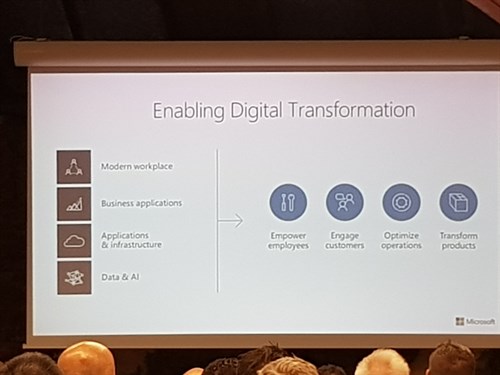
Ernst-Jan continues to lay out Microsoft’s strategy towards IoT. By collecting, ingesting, analyzing data and acting upon that data, customers can be smarter than ever before, being able to build solutions that were unthinkable in the past. He shares some IoT use cases examples at Dutch Railways, City of Breda, Rijkswaterstaat and Q-Park to illustrate this.
[BE] Opening keynote – Michael Beal, Microsoft BeLux
Michael started explaining what digital transformation means and the vision of Microsoft on that subject. Microsoft is focusing on empowering people and building trust in Technology.
Michael continued his talk with the vision of Microsoft on the Intelligent cloud combined with an intelligent edge. To wrap up, Michael talked about how Microsoft thinks about IoT and how Microsoft is focusing on simplifying IoT.
Democratizing IoT by allowing everyone to access the benefits of IoT and providing the foundation of Digital Transformation is one of the core missions of Microsoft in the near future.
A great inspiring talk to start the day with in Belgium.
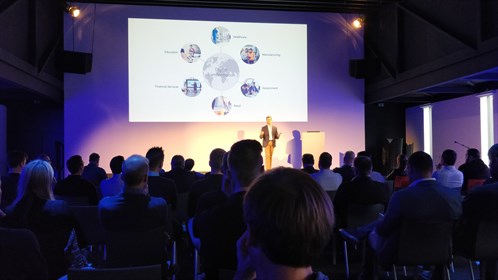
[NL/BE] Hybrid Integration and the power of Azure Services – Jon Fancey, Microsoft Corp
Jon Fancey is a Principal Product Manager at Microsoft and is responsible for the BizTalk Server, Logic Apps and Azure API Management products.
He shares his vision on integration and the fact there is a continuous pressure between the forces and trends in the market. He explains that companies need to manage change effectively to be able to adapt in a quickly changing environment.
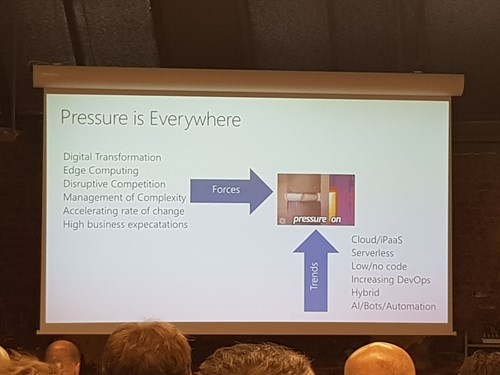
Azure enables organizations to innovate their businesses. To deal with digital disruptions (rapid evolving technology), Digital Transformation is required. Jon goes through the evolution of inter-organizational communication technologies from EDI, RPC, SOAP, REST to Swagger/Open API.
Logic Apps now has 160+ connectors currently available for all types of needs: B2B, PaaS support, SaaS, etc…. This number is continually growing, if needed you can build your own connector and use that in your Logic Apps.
Today, Azure Integration Services consist of BizTalk Server, Logic Apps, API Management, ServiceBus and Azure Functions. Each of these components can be leveraged in several scenarios and, when combined, can fulfill unlimited opportunities. Jon talks about serverless integration. Key advantages are reduced DevOps effort, reduced time-to-market and per action billing.
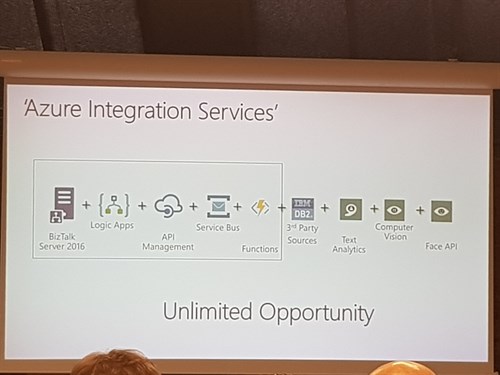
[NL] Mature IoT Solutions with Azure – Sam Vanhoutte, Codit
In this session Sam Vanhoutte, CTO of Codit, explained us how businesses can leverage IoT solutions to establish innovation and agility.
He first showed us some showcases from enterprises that are using IoT today to create innovative solutions with a relatively small effort. All that while gaining a very high TCO. He showed us how a large transport company combined Sigfox (an IoT connection service), geofencing and the Nebulus IoT gateway to track “black circuit” movements of containers. Sam also showed us how a large manufacturer of food processing machines uses IoT to connect existing machines to gather data for remote monitoring and predictive maintenance, even though these machines communicate with legacy protocols.
Next, Sam reflected on the pitfalls of IoT projects and how to address them. He stressed the importance of executive buy-in. Solutions will rarely make it to production if this is lacking. Sam also advised to use the existing installed-base of enterprises in order to decrease the time to market and add value fast. This can be achieved by adding a IoT gateway. Also, you need to think about how to process all the data these devices are generating and add some filtering and aggregation before storage costs become too high. Sam then stressed the importance of security and patching the devices.
One last thing to keep in mind is to spend your money and time wisely in an IoT project. Use the bits and pieces from the cloud patform that are already there and focus on value generators. In the last part of the presentation, Sam showed us how the Nebulus gateway takes care of the heavy lifting of connecting devices and how it can jumpstart a companies’ journey into its first IoT project.
[BE] Cloud Integration: What’s in it for you? – Toon Vanhoutte & Massimo Crippa, Codit
During this session Toon Vanhoutte (Lead Architect) and Massimo Crippa (API Management Domain Lead) gave us more information about different integration scenarios.
Massimo started with showing us the different scenarios as they were yesterday, today and how it will become tomorrow. In the past everything was On-Premise. Nowadays we have a hybrid landscape which includes the huge advantage of connectivity, for example the ease of use of Logic Apps. There is also the integrated azure environment, the velocity e.g. the continuous releases for LogicApps and the network (VNET integration).
Toon introduced Cloud Integration which has the following advantages. Serverless technology, migration path, the pricing is consumption based and the use of ALM which stands for continuous integration & delivery. The shift towards the cloud can start with IAAS (Infrastructure as a service). The main advantages of IAAS are : availability, security and the lower costs. But why we should choose for Hybrid Integration? Flexibility and agility towards your customers and it is future proof. Serverless integration reduces the total cost of ownership, you have less devops, you can instantly scale your setup with a huge business value.
Massimo told us that security is very important through governance, firewall, identity and access rules. Another topic is monitoring, in the below photo you have all of the different types of monitoring.
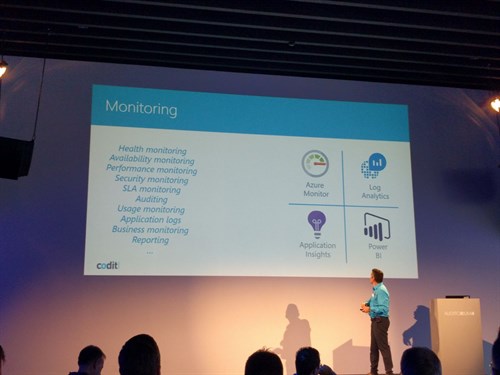
The Codit approach in moving forward is a mix between on-premise (Biztalk – Sentinet – SWL server) and an Azure infrastructure.
[NL] The Microsoft Integration Platform – Steef-Jan Wiggers, Codit
The presentation of Steef-Jan started with an overview of the application landscape from yesterday’s, today’s and tomorrow’s organizations. Previously, all applications, which were mostly server products, were running at on-premises data centers. Today, the majority of the enterprises have a hybrid application landscape: the core applications are still running on-premises, but they are already using some SaaS applications in the cloud . Tomorrow, cloud-based applications will take over our businesses
The integration landscape is currently undergoing a switch from on-premises to hybrid to the cloud. On-premise integration is based on BizTalk Server and Sentinet for API Management. BizTalk is used for running missing-critical productions workloads and Sentinet for virtualizing API’s with minimal latency. Both have been made cloud ready. Adapters for Logic Apps (On premise Gateway) and Service Bus (Queues, Topics and Relay) have been added in BizTalk, for Sentinet integration with Azure Service bus and more focus on REST, OAuth and OpenID. In Hybrid Integration, Logic Apps is used for connecting the cloud and API Management as well.
You have the advantage of continuous releases, moving faster and adapting faster to change. For networking you can use VNET and Relays. Cloud Integration has the advantage of Serverless integration (no server installation & patching, inherent high availability, …).
The pricing is consumption based: pay per executed action.
Different paths are available to switch from on-premises to cloud: “it should be a natural evolution and not a revolution”.
One way is IaaS integration for obtaining better availability for your server infrastructure. IaaS improves security and has less costs. Hybrid integration gives you flexiblity in your application landscape. It is agile towards the business and you can release faster. A hybrid setup ensures you are set for the future. Serverless integration reduces the efforts you put in operations tremendously: no more server patching, backups… The costs are lower and you have the advantage to be able to scale much faster as well.
The Codit Approach
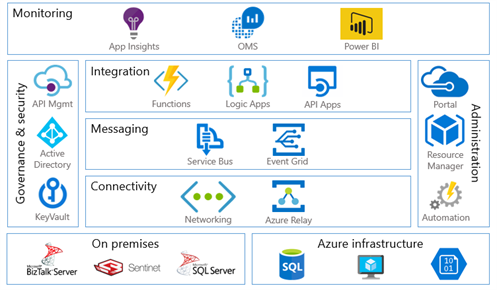
If you look at the hybrid integration platform you can distinguish several blocks. On premises has the known integration technologies. In Azure you find the standard compute and storage options. Connectivity enables smooth integration between on premises and the cloud. Messaging solutions like Service Bus and Event Grid allow decoupling of application. For integration, Logic Apps are used which orchestrate all integrations that can be extended via Azure Functions and API Apps. Integration with Azure API Management ensures governance and security using of Azure AD and Azure Key Vault. Administration and operations are done by using VSTS Release Management to rollout the solutions throughout the DTAP street in a consistent manner. A role-based monitoring experienced is offered by App Insights for developers, OMS for operations and Power BI reports for business users.
Codit wants you to be fully connected: Integration is the backbone of your Digital Transformation. Now more than ever.
[NL] update links – How the Azure ecosystem is instrumental to your IoT solution – Glenn Colpaert, Codit
IoT is here to stay so we’d better get ready for it. In the future everything will be connected, even cows. Glenn kicked off his session by giving a good overview of all main IoT pillars ranging from data storage & analytics to edge computing and connectivity and device management. Of course, that’s not the only things to take into account. Security is often forgotton about, or “applied on top of it” later on. But security should be designed from the ground up. Microsoft’s goal is to simplify IoT on several perspectives: Security, Device Management, Insights, Edge. Microsoft Azure provides a whole ecosystem of services that can assist you with this:
- Azure IoT Hub that provides a gateway between the edge and the cloud with Service Assisted Communications built-in by default
- Perform near-real-time stream processing with Azure Stream Analytics
- Write custom business logic with Service Fabric or Azure Functions
- Enable business connectivity with Azure Logic Apps for building a hybrid story
- Azure Time Series Insights enabling real-time streaming insights
- Setup DevOps pipelines with Visual Studio Team Services
However, when you want to get your feet wet: Azure IoT Central & Solutions are very easy. Start small and play around before spending a big budget on custom development. By using a Raspberry Pi simulator Glenn showed how easy it is to send telemetry to Azure IoT Hub and how you can visualize all the telemetry without writing a single line of code with Azure Time Series Insights. The key take-aways from this session are:
- Data Value is created by making sense of your data
- Insights Connect insights back to business
- Security Start thinking about security from day zero
- Edge IoT Edge is there for low latency scenarios
- Evolve Learn by experience with new deployments
If you are interested in learning more about data storage & analytics, we highly recommend reading Zoiner Tejada’s Mastering Azure Analytics
[NL/BE] Event-Driven Serverless Architecture – the next big thing in the cloud – Clemens Vasters, Microsoft Corp
Clemens starts the session with explaining the “Serverless” concept, which frees you entirely from any infrastructure pain points. You don’t have to worry about patching, scaling and all the other infrastructure tasks that you normally have in a hosted environment. It lets you solely focus on your apps & data. Very nice! Clemens teaches us that there are different PaaS options for hosting your services, each having its own use cases and advantages.
Managed Cluster
Applications are being deployed on a cluster that handles the placement, replication, ownership consensus and management of stateful resources. This option is used to host complex, stateful, highly reliable and always-on services.
Managed Middleware
Applications are deployed on sets of independant “stateless” middleware servers, like web servers or pure compute hosts. These applications may be “always-on” or “start on demand” and typically maintain a shared cached state and resources.
Managed Functions
Function implementations can be triggered by a configured condition (event driven) and are short lived. There is a high level of abstraction of the infrastructure where your function implementations are running. Next to that, you have different deployment models you can use to host your services. The classic “monolith” approach divides the functional tiers on designated role servers (like a web server, database server,…). The disadvantage of this model is that you need to scale your application by cloning the service on multiple servers or containers. The more modern approach is the “microservice” approach, where you seperate functionality into smaller services and host them as a cluster. Each service can be scaled out independently by creating instances across servers or containers. It’s an autonomous unit that manages a certain part of a system and can be built and deployed independently.
[BE] Maturing IoT Solutions with Microsoft Azure – Sam Vanhoutte & Glenn Colpaert, Codit
Sam and Glenn kicked off their session talking about the IoT End-to-End Value chain. A typical IoT solution chain is comprised of the following layers:
- Devices are the basis for the IoT solution because they connect to the cloud backend.
- The Edge brings the intelligence layer closer to the devices to reduce the latency.
- Gateways are used to help devices to connect with the cloud.
- The Ingestion layer is the entry into the IoT backend and is typically the part that must be able to scale out to handle a lot of parallel incoming data streams from the (thousands of) devices.
- The Automation layer is where business rules, alerting and anomaly detection typically take place.
- The Data layer is where analytics and machine learning typically take place and where all the stored data gets turned into insights and information. Report and Act is all about turning insights in action, where business events get integrated with the backend systems, or where insights get exposed in reports, apps or open data.
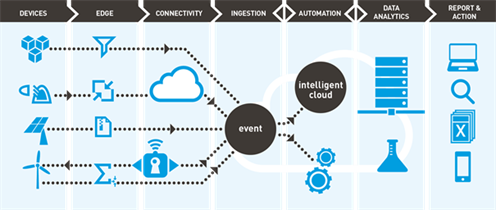
At Codit, we have built a solution, the Nebulus IoT Gateway, that helps companies jump start the IoT connectivity phase and generate value as quickly as possible. The Gateway is a software-based IoT solution that instantly connects your devices to (y)our cloud. The gateway provides all required functionality to cope with connectivity issues, cloud-based configuration management and security challenge.
As integration experts, we at Codit can help you simplify this IoT Journey. Our IoT consultants can guide you through the full IoT Service offering and evolve your PoC to a real production scenario.
The session ended with the following conclusion:
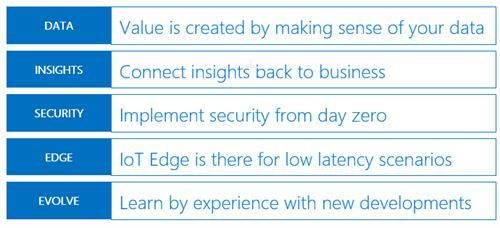
[NL/BE] Closing keynote – Richard Seroter, Pivotal
The theory of constraints tells you the way to improve performance is to find and handle bottlenecks. This also applies to Integration and the software delivery of the solution. It does not matter how fast your development team is working if it takes forever to deploy the solution. Without making changes, your cloud-native efforts go to waste.
Richard went on comparing traditional integration with cloud-native integration, showing the move is also a change in mindset.
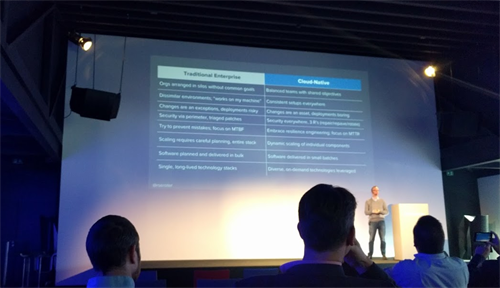
A cloud-native solution is composable: it is built out by chaining together independent blocks allowing targeted updates without the need of downtime. This is part of the always-on feature of the integration: a cloud-native solution assumes failure and is built for it. Another aspect of the solution is that it’s built for scale; The solution scales with demand, and the different components do this separately. Making the solution usable for ‘citizen integrators’ by developing for self-service, will reduce the need for big teams of integration specialists. The integration project should be done with the modern resources and connectors in mind allowing for more endpoints and data streams. The software lifecycle will be automated; The integration can no longer be managed and monitored by people. Your software is managed by your software.
Thank you for reading our blog post, feel free to comment or give us feedback in person. You can find the presentations of both days on following links:
This blogpost was prepared by:
Glenn Colpaert – Nils Gruson – René Bik – Jacqueline Portier – Filiep Maes – Tom Kerkhove – Dennis Defrancq – Christophe De Vriese – Korneel Vanhie – Falco Lannoo
Subscribe to our RSS feed